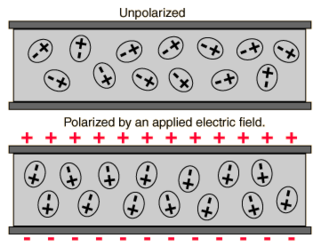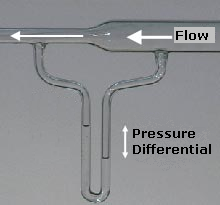
In precise timekeeping, ΔT is a measure of the cumulative effect of the departure of the Earth's rotation period from the fixed-length day of atomic time. Formally, ΔT is the time difference ΔT = TT − UT between Universal Time and Terrestrial Time. The value of ΔT for the start of 1902 was approximately zero; for 2002 it was about 64 seconds. So the Earth's rotations over that century took about 64 seconds longer than would be required for days of atomic time. As well as this long-term drift in the length of the day there are short-term fluctuations in the length of day which are dealt with separately.
In physics, power is the amount of energy transferred or converted per unit time. In the International System of Units, the unit of power is the watt, equal to one joule per second. In older works, power is sometimes called activity. Power is a scalar quantity.

A calorimeter is an object used for calorimetry, or the process of measuring the heat of chemical reactions or physical changes as well as heat capacity. Differential scanning calorimeters, isothermal micro calorimeters, titration calorimeters and accelerated rate calorimeters are among the most common types. A simple calorimeter just consists of a thermometer attached to a metal container full of water suspended above a combustion chamber. It is one of the measurement devices used in the study of thermodynamics, chemistry, and biochemistry.

In electromagnetism, the absolute permittivity, often simply called permittivity and denoted by the Greek letter ε (epsilon), is a measure of the electric polarizability of a dielectric. A material with high permittivity polarizes more in response to an applied electric field than a material with low permittivity, thereby storing more energy in the material. In electrostatics, the permittivity plays an important role in determining the capacitance of a capacitor.

In fluid dynamics, Bernoulli's principle states that an increase in the speed of a fluid occurs simultaneously with a decrease in static pressure or a decrease in the fluid's potential energy. The principle is named after Daniel Bernoulli who published it in his book Hydrodynamica in 1738. Although Bernoulli deduced that pressure decreases when the flow speed increases, it was Leonhard Euler in 1752 who derived Bernoulli's equation in its usual form. The principle is only applicable for isentropic flows: when the effects of irreversible processes and non-adiabatic processes are small and can be neglected.
Proper length or rest length is the length of an object in the object's rest frame.

In classical mechanics, areal velocity is a pseudovector whose length equals the rate of change at which area is swept out by a particle as it moves along a curve. In the adjoining figure, suppose that a particle moves along the blue curve. At a certain time t, the particle is located at point B, and a short while later, at time t + Δt, the particle has moved to point C. The region swept out by the particle is shaded in green in the figure, bounded by the line segments AB and AC and the curve along which the particle moves. The areal velocity magnitude is this region's area divided by the time interval Δt in the limit that Δt becomes vanishingly small. The vector direction is postulated normal to the plane containing the position and velocity vectors of the particle, following a convention known as the right hand rule.
A numerical model of the Solar System is a set of mathematical equations, which, when solved, give the approximate positions of the planets as a function of time. Attempts to create such a model established the more general field of celestial mechanics. The results of this simulation can be compared with past measurements to check for accuracy and then be used to predict future positions. Its main use therefore is in preparation of almanacs.

In physics, the Thomas precession, named after Llewellyn Thomas, is a relativistic correction that applies to the spin of an elementary particle or the rotation of a macroscopic gyroscope and relates the angular velocity of the spin of a particle following a curvilinear orbit to the angular velocity of the orbital motion.
A calorimeter constant is a constant that quantifies the heat capacity of a calorimeter. It may be calculated by applying a known amount of heat to the calorimeter and measuring the calorimeter's corresponding change in temperature. In SI units, the calorimeter constant is then calculated by dividing the change in enthalpy (ΔH) in joules by the change in temperature (ΔT) in kelvins or degrees Celsius:
Delta commonly refers to:
The triple product rule, known variously as the cyclic chain rule, cyclic relation, cyclical rule or Euler's chain rule, is a formula which relates partial derivatives of three interdependent variables. The rule finds application in thermodynamics, where frequently three variables can be related by a function of the form f(x, y, z) = 0, so each variable is given as an implicit function of the other two variables. For example, an equation of state for a fluid relates temperature, pressure, and volume in this manner. The triple product rule for such interrelated variables x, y, and z comes from using a reciprocity relation on the result of the implicit function theorem, and is given by
In mathematics, the semi-implicit Euler method, also called symplectic Euler, semi-explicit Euler, Euler–Cromer, and Newton–Størmer–Verlet (NSV), is a modification of the Euler method for solving Hamilton's equations, a system of ordinary differential equations that arises in classical mechanics. It is a symplectic integrator and hence it yields better results than the standard Euler method.
Searle's bar method is an experimental procedure to measure thermal conductivity of material. A bar of material is being heated by steam on one side and the other side cooled down by water while the length of the bar is thermally insulated. Then the heat ΔQ propagating through the bar in a time interval of Δt is given by

Thermal destratification is the process of mixing the internal air in a building to eliminate stratified layers and achieve temperature equalization throughout the building envelope.
The symbols Δt and ΔT are commonly used in a variety of contexts.
Temporal discretization is a mathematical technique applied to transient problems that occur in the fields of applied physics and engineering.
The convection–diffusion equation describes the flow of heat, particles, or other physical quantities in situations where there is both diffusion and convection or advection. For information about the equation, its derivation, and its conceptual importance and consequences, see the main article convection–diffusion equation. This article describes how to use a computer to calculate an approximate numerical solution of the discretized equation, in a time-dependent situation.
This page is based on this
Wikipedia article Text is available under the
CC BY-SA 4.0 license; additional terms may apply.
Images, videos and audio are available under their respective licenses.






